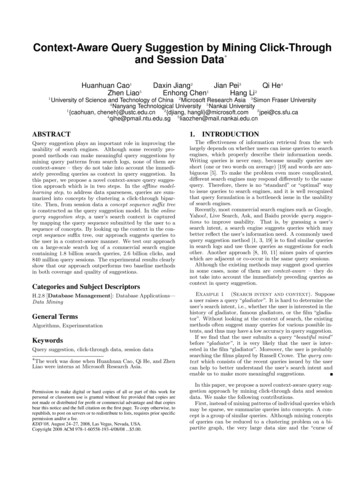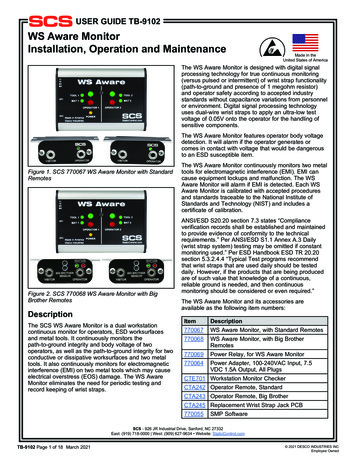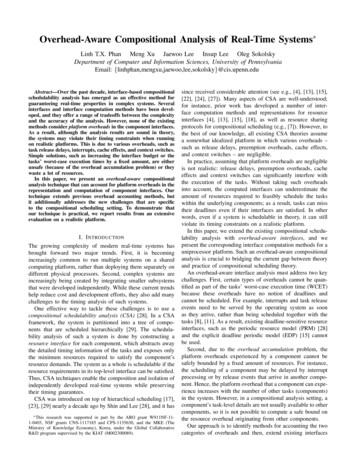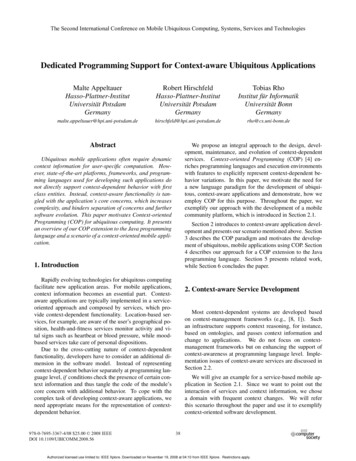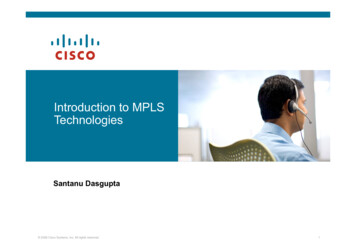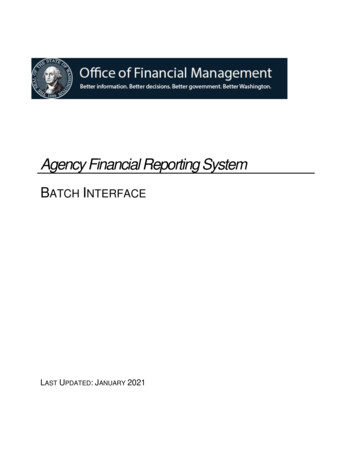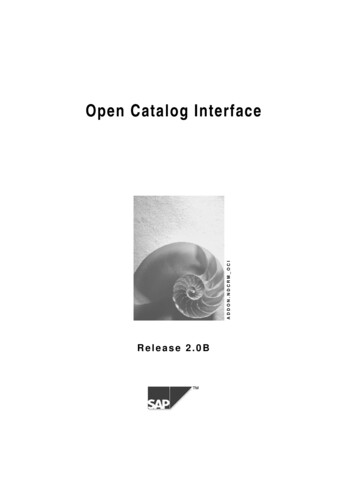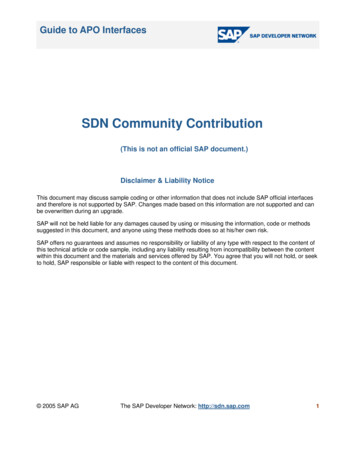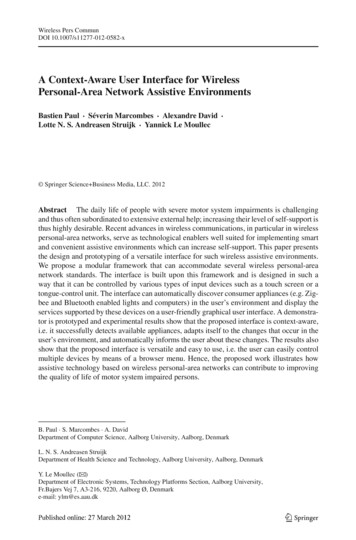
Transcription
Wireless Pers CommunDOI 10.1007/s11277-012-0582-xA Context-Aware User Interface for WirelessPersonal-Area Network Assistive EnvironmentsBastien Paul · Séverin Marcombes · Alexandre David ·Lotte N. S. Andreasen Struijk · Yannick Le Moullec Springer Science Business Media, LLC. 2012Abstract The daily life of people with severe motor system impairments is challengingand thus often subordinated to extensive external help; increasing their level of self-support isthus highly desirable. Recent advances in wireless communications, in particular in wirelesspersonal-area networks, serve as technological enablers well suited for implementing smartand convenient assistive environments which can increase self-support. This paper presentsthe design and prototyping of a versatile interface for such wireless assistive environments.We propose a modular framework that can accommodate several wireless personal-areanetwork standards. The interface is built upon this framework and is designed in such away that it can be controlled by various types of input devices such as a touch screen or atongue-control unit. The interface can automatically discover consumer appliances (e.g. Zigbee and Bluetooth enabled lights and computers) in the user’s environment and display theservices supported by these devices on a user-friendly graphical user interface. A demonstrator is prototyped and experimental results show that the proposed interface is context-aware,i.e. it successfully detects available appliances, adapts itself to the changes that occur in theuser’s environment, and automatically informs the user about these changes. The results alsoshow that the proposed interface is versatile and easy to use, i.e. the user can easily controlmultiple devices by means of a browser menu. Hence, the proposed work illustrates howassistive technology based on wireless personal-area networks can contribute to improvingthe quality of life of motor system impaired persons.B. Paul · S. Marcombes · A. DavidDepartment of Computer Science, Aalborg University, Aalborg, DenmarkL. N. S. Andreasen StruijkDepartment of Health Science and Technology, Aalborg University, Aalborg, DenmarkY. Le Moullec (B)Department of Electronic Systems, Technology Platforms Section, Aalborg University,Fr.Bajers Vej 7, A3-216, 9220, Aalborg Ø, Denmarke-mail: ylm@es.aau.dk123
B. Paul et al.Keywords Context-aware control interface · Wireless assistive environments ·Service discovery · Motor system impairments · Tongue-controlled interface1 IntroductionSpinal Cord Injuries (resulting in quadriplegia), brain injury and other sources of motor system impairments raise severe barriers for individuals who are subject to these. Very often,their daily lives are challenging and activities that we take for granted can be or can becomeout of scope for these individuals. These activities include, among others, attending school,having a job, and socializing. In such situations, life is subordinated to extensive or continuous external help; however, there are cases where technology makes it possible to increasethe level of self-support of these individuals, and in turn can improve their Quality of Life(QOL).Over the last two decades, the amount of work carried out in the multidisciplinary domainsof Assistive Technology (AT) and e-health [1] has been increasing, encouraged by the evolution of available technologies such as sub-micron VLSI digital circuits, digital signal processing platforms, and, more recently, advances in wireless communications, in particular interms of Wireless Personal-Area Networks (WPAN) based on e.g. Zigbee and Bluetooth. Thecombination of these technologies pave the way for advanced systems which can improvethe QOL of people with motor system impairments by enabling them to control their environments (e.g. in smart homes) and to access modern communication channels (e.g. email,web, audio/video calls). This is a domain that has witnessed many research and development efforts [2]. Indeed, even when living with severe impairments such as quadriplegia,people are often still able to move body parts such as jaws, eyes, head, and tongue. Researchefforts have resulted in several types of adapted control systems that enable disabled peopleto control their environment, e.g. their wheelchair, lights, TVs, computers. Although manypromising concepts have been demonstrated, only a limited fraction of these environmentalcontrol systems have become widely accepted by the users; price, ease of control, aesthetics, and social cost are essential issues that can determine the adoption and success of suchsystems [3,4].Home medical equipment is expensive and not always affordable without health insurance compensation. Any added feature that increases the overall price too much has reducedchances to become widespread. Typically, AT relies on three major parts [2]. The first one,the “access pathway” is composed of the physical sensors or input devices actuated by theuser; their outputs are then converted into electrical signals which are further analyzed bymeans of digital signal processing techniques. In the context of severe motor system impairment, access pathway examples include control systems based on the eye, head, brain, ortongue actuation. The second part is the actual “user interface” which analyzes the digitallyprocessed input signals and converts them into output signals. These output signals are thenused to enable the third part, i.e. “functional activities” such as controlling appliances in theuser’s environment.Ideally, the user interface should be versatile so that it enables the user to interact with asmany types of devices located in his/her environment as possible, as transparently as possible. Moreover, aesthetics is too often underestimated; in many cases it is highly desirableto minimize the feeling of being “different” so that the control system can be accepted andadopted by the users [5]. Two of the above mentioned issues, namely aesthetics and accesspathway, have been investigated at Aalborg University and have resulted in a fully integratedwireless inductive tongue control system [6,7]. The work presented in the current paper deals123
A Context-Aware User InterfaceFig. 1 Illustration of the proposed interface for controlling appliances in a wireless assistive environment.The work presented in this paper is delimited by the dashed boxwith the design and prototyping of a user interface, i.e. a versatile interface which could beused together with (but is not limited to) the above mentioned tongue control system. Theproposed interface exploits the fact that wireless features are increasingly found in dailyappliances and that inexpensive and versatile embedded systems (e.g. microcontroller-basedLinux platforms) are more and more widespread. This interface automatically discovers wireless-enabled appliances (e.g. Zigbee-enabled lights, Bluetooth-enabled computers), displaystheir services on the visual interface and lets the user control them by means of an accesspathways (input) device, which could be, for example, a touch screen (part of the proposedinterface) or a tongue control system (e.g. [6,7]). The AT scenario considered for this work isillustrated in Fig. 1, where the work presented in the current paper is delimited by the dashedbox.The remainder of this paper is organized as follows. Section 2 briefly reviews related worksin terms of (i) assistive technologies for motor system impaired persons and (ii) discovery,multi-protocol compatibility and context awareness. It also summarizes our contributions.Section 3 presents the design of the proposed user interface and the underlying discoveryand connectivity mechanisms. Section 4 presents the prototyping of the proposed interfaceand Sect. 5 presents the experimental setup and results. Finally, Sect. 6 discusses the resultsand suggests directions for future work.2 Related Work and Contributions2.1 Related WorkEarlier works in terms of assistive technologies for motor system impaired persons include,among others, [8] that proposes a palatal tongue controller consisting of touch-sensitive padsmounted on the surface of the dental plate. A transmitter embedded in the dental plate transmits switch activations remotely to external devices fitted with receivers. Computers in theuser’s environment can be controlled via a mouse emulator whereas other appliances arecontrolled via infrared signals; however, its users may have to face challenges due to thelimitations of that specific technology (e.g. line-of-sight and code learning). [9] describes123
B. Paul et al.a Hall effect-based approach for controlling appliances through tongue movement. Besidesbeing rather complex and physically large, this system requires cables going from the mouthpiece unit to the processing unit. Moreover, no description of the interfacing/control methodsto the devices in the user’s environment is provided. More recently, a ZigBee-based wireless intra-oral control system for quadriplegic patients has been proposed in [10]. Theirsystem is composed of a wireless intra-oral module, a wireless coordinator, and distributedZigBee wireless controllers. The intra-oral module communicates wirelessly with the coordinator which itself communicates wirelessly with the Zigbee controllers to activate externaldevices, depending on the requests made by the user via a GUI. Although their concept andours share a few similarities, they differ significantly on the interfacing aspects: their interfacefor controlling external devices is quite un-versatile since it relies on a static GUI that runson either a PC or a pocket PC and it can only communicate with Zigbee-enabled appliances.[11] reports on an external tongue controlled device that communicates with a PC througha proprietary 2.4- GHz wireless link. An application executing on the PC enables the userto control a powered wheelchair. That paper also suggests the opportunity to control othertypes of appliances by means of a Wi-Fi/Bluetooth enabled PDA, but this is not implementednor discussed. Finally, [12] explores an EOG-based eye tracking technique combined withinfrared and Bluetooth connectivity for controlling appliances in the user’s environment.Although sufficiently compact for being mounted on a wheelchair, their interface is neitherdesigned for tongue control nor versatile enough for accommodating extra wireless protocols.Clearly, the above works have paved the way for improved self-support in terms of environment control; however, there is still room for advancing the opportunities made possibleby technological advances in wireless communications and context-aware computing. Forour application, the ideal interface should not only be wireless, but should also feature mechanisms such as service discovery, multi-protocol compatibility and context awareness. Worksrelated to these features are found in e.g. [13], where service discovery for mobile networkis surveyed, while distance-sensitive service discovery is addressed in [14]; service reconfiguration for ensuring service availability in assistive environments is considered in e.g. [15].Multi-protocol compatibility is investigated in works such as [16–22]. For example, [16]proposes a layered middleware that enables multiple protocol to coexist and [17] considersWi-Fi/Zigbee coexistence. [18] and [19] present translation strategies for KNX-Zigbee andinfrared-Zigbee, whereas [20] proposes a more universal approach by means of a dynamicdevice integration manager that enables transparent service discovery. [21] describes a socalled adaptive-scenario-based reasoning system where adaptive history scenarios are usedto collect and aggregate user habits in smart homes; similarly, [22] suggests a dynamic service composition system for coordinating Universal Plug and Play (UPnP) services in smarthomes and identifying devices that can work together, taking user habits into account.Finally, [23] suggests guidelines and recommendations for constructing robust contextawareness applications; specific context-aware wireless network systems are discussed ine.g. [24] that describes CANE, a Context-Aware Network Equipment for multimedia applications that adapts dynamically to the user’s environment by taking user’s preferences, networkstatus, as well as service requirements and policies into account.2.2 ContributionsTo overcome the limitations of [8–12] we exploit concepts similar to that of [13–24]. Wepresent the design of a context-aware and versatile framework upon which the user interfaceis built. The paper details the mechanisms used so that the framework can (i) discover and123
A Context-Aware User Interfaceconnect seamlessly to WPAN enabled appliances in the user’s environment and (ii) givethe user access to the control and communication services of these appliances. The noveltyof the work is twofold. Firstly, in contrast to existing assistive user interfaces, the one thatwe propose is not limited to a single communication standard or a predefined, fixed set ofstandards. To do so, we propose a discovery and multiprotocol connectivity mechanism combined with a plug-in system that makes the framework versatile enough to accommodate awide range of existing and future WPAN standards. Secondly, the features needed for sucha versatile interface are implemented as an embedded system with hard constraints in termsof size, power, and price so that it could be mounted on e.g. a wheelchair. As opposed todesktop implementations or less constrained embedded implementations, the proposed userinterface can be implemented by means of relatively inexpensive and physically small components with low computational capabilities. Furthermore, a specific power managementsystem (PMS) is designed to reduce the power footprint of the user interface. A demonstratoris prototyped and used to experimentally test the proposed approach. The experiments showthat the proposed interface is context-aware, i.e. it successfully detects available appliances,adapts itself to changes that occur in the user’s environment, and automatically informs theuser about these changes. Furthermore, the proposed interface is versatile and easy to use,i.e. the user can easily control multiple devices by means of a browser menu.3 Design3.1 Design ConsiderationsThe purpose of the proposed interface is to provide the necessary features for (i) enablingthe connection of various access pathway (input) types, such as e.g. a touch screen or atongue control unit, with multiple WPAN-enabled appliances in the user’s environment and(ii) enabling the user to interact with those appliances. To implement the above, the followingdesign aspects have been considered: The interface must be versatile enough to accommodate a significant set of appliances;as the number of wireless standards and home automation products is expanding, theinterface must be flexible and upgradable.Using appliances through the interface must be as easy as it would with their nativeinterfaces. In particular, the user should not feel the need for having someone to helphim or her when interacting with the appliances. Similarly, the interface must providean “easy first-time installation” procedure.The interface must provide the user with the possibility to switch easily and quicklybetween the appliances, without disrupting their operation. Support for some form ofmultitasking is thus needed.Moreover, the interface must be aware of its environment (i.e. able to detect availableappliances) and inform the user about it (i.e. maintain a list of available appliances andtheir respective services and present them visually to the user).Finally, as the interface is expected to be on mounted on e.g. wheelchairs, the size andpower factors are critical and should be kept as low as possible.Regarding the networking aspect, this work combines various standard protocol stack layers; this makes that interoperability with multiple protocols stacks only requires that WPANenablers, such as Bluetooth or Zigbee, are already available or installed on the appliance.Protocols using Service Oriented Architectures (SOA) are used here since they enable ser-123
B. Paul et al.Table 1 Examples of stack combinations for the proposed interface#Application stackNetwork stackPhysical stack1Bluetooth profiles SDPBluetooth802.15.1 (Bluetooth)2Zigbee profiles SDPZigbee802.15.43DLNA UPnPTCP/IPv4802.11.X (Wi-Fi)4DLNA UPnPTCP/IPv6802.11.X (Wi-Fi)5DLNA UPnP6LoWPAN (TCP/IPv6)802.15.46DLNA UPnPTCP/IP Bluetooth802.15.1 (Bluetooth)vice discovery and service access. Examples of possible combinations of standard protocolsproviding both a physical layer and an application layer, as targeted in this work, are listedin Table 1. Although many SOA-based protocols implementing an application layer wouldbe suitable for this work, the DLNA (Digital Living Network Alliance) specification is currently the only one broadly implemented in consumer appliances. Besides supporting UPnP,DLNA also enables the targeted users of the proposed interface to enjoy various audio andvideo media. The six combinations shown in Table 1 are the ones that have been considered.However, as the proposed interface is modular, this list can easily be extended.To make it versatile and expendable with future standards, the framework has beendesigned following a modular approach. Its constituting elements fall into three main categories: devices, protocols, and functionalities. Each of these categories includes classes,plug-ins and extensions, as described in the following sections.3.2 Listing Controllable AppliancesRemote appliances are represented by means of the ‘Device’ class; each device has a name, alocation, a unique ID, an icon, as well as a type (light, computer ); thus remote appliancesare represented by means of objects derived from both the ‘Device’ and ‘Type’ classes.3.3 Listing Accessible Functionalities‘Service’ is the most generic class that can define a functionality, depending on the protocol it belongs to and its family. All devices are aggregated, through the ‘Element’ class, inthe ‘ConcurrentList’ class that is used to add, access, or remove a device. Objects derivedfrom the ‘Service’ class represent supported functionalities. Each ‘Device’ contains a listof the ‘Services’ (i.e. functionalities) it offers. Functionalities are referred to as ‘services’.Each functionality is therefore represented by an object derived from the ‘Service’ class.A summary of the connections between these classes is shown in Fig. 2.3.4 Awareness of and Adaptation to the User’s EnvironmentWhen the user moves from place to place or when appliances are displaced, the appliancesseen by the framework enter or leave its coverage range. For usability sake, device discovering must take place without any command from the user. This is supported by the ‘Protocol’class. The ‘Protocol’ class defines all protocol-related attributes and methods the frameworkcan use. Adding new protocols is rather easy since it only requires a new class derived from‘Protocol’ to describe the given protocol; ‘Protocol’ plug-ins also have to define extensionsto the ‘Device’ class. Another aspect is that communication activities should not prevent the123
A Context-Aware User InterfaceFig. 2 The ‘ConcurrentList’ class aggregates the ‘Device’ and ‘Service’ classes through the ‘Element’ classFig. 3 ‘ProtocolManager’ connects the ‘Protocol’ and ’ConcurrentList’ classes by aggregating the protocols(e.g. Zigbee and Bluetooth)system from being responsive to the user’s actions. This is supported by means of threads:the communication activities are performed by one or several threads while the GUI is performed by another one, thus the framework is reactive and can continuously adapt to theuser’s environment. Adaptation is achieved by means of the discovery features of the considered protocols. The ‘Protocol’ class is responsible for discovering devices and for adding orremoving them from the list. Moreover, the GUI has to have access to the list of ‘Element’ justlike ‘Protocol’ that is implemented in another thread. To avoid any conflict, ‘ConcurrentList’provides a mutex mechanism to protect the access to the list of devices. These elements areconnected through the ‘ProtocolManager’ class, as shown in Fig. 3.‘ProtocolManager’ aggregates all the protocols and ‘ConcurrentList’ is implemented ina thread where all the protocols are to be executed. ‘ProtocolManager’ manages a threaddedicated to device and service discovery. To represent a remote appliance, the ‘Protocol’plug-in instantiates a subclass of the ‘Device’ class adapted to its needs in terms of e.g. datastorage. These instances are then attached to the object that represents the appliance.123
B. Paul et al.3.5 Switching Between DevicesSwitching rapidly from one device to another is made possible by not terminating open connections when performing the switch. Instead, these connections are kept alive for a certainduration, or set in an idle mode that is less energy consuming, depending on the needs of theservices and on the properties of the protocols. When a protocol does not support multipleconnections, switching between devices may imply terminating an active connection: in thiscase, the termination is done in such a way that the current state of the appliance is notmodified.3.6 ModularityModularity is achieved by means of a plug-in mechanism which supports new technologies(protocol-dependent plug-ins) and new functionalities (functionality plug-ins). A plug-inis a library used by the framework and contains the definition of protocol-dependent andtype-dependent devices as well as the definition of specific protocols. Figure 4 shows howthe plug-in mechanism relates to the framework (in grey) and the dependencies betweenthe plug-ins. ‘Devices’ (red) represent appliances such as computers and lights. ‘Services’(orange) define the supported services and their associated GUI items. ‘Protocols’ (pink)bring connectivity support in conjunction with ‘Device Definition’ (purple) and ‘ServiceDefinition’ (blue). Plug-ins are composed of three main classes and, optionally, a set of otherclasses providing the plug-in implementation: the ‘Implementation’ class that depends on theplug-in type, the ‘Plug-in’ class which creates an instantiation of the implementation classand contains the dependency information between plug-ins, and the ‘Loader’ class whichregisters the plug-in class in the framework. Finally, a plug-in manager loads all plug-ins.FrameworkDeviceServiceGUIProtocols Protocols Zigbee Device Light Device ComputerLightComputerloader Service Mouse Service Activation Protocols BluetoothZigbeeBluetooth Service viceBluetoothloaderLoaderloaderloader Device Protocol ComputerBluetoothComputerBluetoothloader Service Protocol MouseByBluetoothMouseByBluetoothloader Service Protocol ActivationByZigbeeActivationByZigbeeloader Service Protocol DimmerByZigbeeDimmerByZigbeeloader Device Protocol LightZigbeeZigbeeLightloaderFig. 4 Plug-ins dependencies Framework (grey). Devices (red). Services (orange). Protocols (pink). DeviceDefinition (purple), and Service Definition (blue)123
A Context-Aware User InterfaceFig. 5 Illustration of the GUI architecture. It is possible to select the appliance to be controlled (e.g. a light),to configure and activate it, and to access its features (e.g. turn on/off) by means of the left, right, up, down,click and escape commands available on e.g. the tongue-control unit and the touch-screenWhen loaded, plug-ins register themselves automatically in the plug-in manager; then themanager checks the dependencies. The manager is also responsible for unloading plug-ins.In the current AT scenario, it is expected that several types of access pathways (input)devices could be used for navigating through the GUI, for example a touch screen or thetongue-control system described in [1]. In order to avoid user’s fatigue, the GUI has beendesigned so that the number of required movements and clicks is minimized. Figure 5 illustrates how it is possible to select the appliance to be controlled (e.g. a light), to configure andactivate it, and to access its features (e.g. turn on/off) by means of the left, right, up, down,click, and the escape commands. The GUI is integrated with the framework as shown inFig. 6. When the user switches to a device, a service or a configuration panel, the displayedobject (e.g. device, service or configuration) is associated to the corresponding class. Thisclass then reads the required information and displays them on the screen.3.7 Managing the PowerA PMS has been designed and implemented. The role of the PMS is to minimize power bycombining several techniques, both at the physical (HW) and framework (SW) levels. Thefollowing techniques are applied at the hardware level: (i) dynamically scaling the frequencyand voltage of the CPU, (ii) turning off the touch panel when unused, (iii) diming or turningoff the backlight when unused, (iv) using the RAM low power mode, (v) exploiting the low123
B. Paul et al.Fig. 6 Integration of GUI with the framework ‘Service’ is associated with ‘ServicesGUI’ and ‘ConfigServiceGUI’, ‘Device’ with ‘DeviceGUI’ and ‘ConfigDeviceGui’, and ‘Framework’ with ‘ConfigFrameworkGUI’power facilities provided by communication protocols, and (vi) turning off the various chipswhen unused. At the software level, flags and timers are used to determine how and whento apply the above techniques. This removes the need for monitoring the system usage andeases the detection of service requests. As seen in Fig. 7, the core of the PMS (i.e. for theCPU/memory) consists of four modes (‘Run’, ‘Conservative’, ‘Sleep’, ‘Shutdown’). Whenthe period of time a user is inactive reaches a first threshold value, the system switchesfrom ‘Run’ to ‘Conservative’ where the voltage and frequency of the CPU are decreased.If the inactivity period exceeds a second, larger threshold value, the system switches to‘Sleep’ where the memory is set to self-refresh and the wireless chips in stand-alone modes.Any activity while in the ‘Conservative’ or ‘Sleep’ modes makes the system to switch backto ‘Run’. Finally, all the components are turned off when the system enters ‘Shut down’.A flag is used so that when a service needs the CPU computational power, the system doesnot switch to the ‘Conservative’ (and thus ‘Sleep’) modes. Similarly (not shown in Fig. 7),the backlight is dimmed or turned off when inactivity thresholds are reached. A flag is usedso that when a service needs to display visual feedback, the system does not switch to thedimmed and off modes.Regarding the wireless modules, several strategies are used. These include limiting discoverability and connectivity, performing radio collision avoidance, communicating in lowpower modes whenever possible, switching to stand-by modes based on usage probabilities,and modulating the period and type of discovery according to the probability of findingdevices around the user.4 Prototyping4.1 Prototyping PlatformThe demonstrator has been prototyped on a platform composed of the following elements.The core of the platform is Atmel’s AT91SAM9263-EK Evaluation Kit [25] featuring among123
A Context-Aware User InterfaceFig. 7 The core of the power management system consists of four modes. As user inactivity reaches thresholds, the system is switched to the conservative and sleep modes; user activity makes the system return to theRun modeothers, an AT91SAM9263 micro-controller and a 3.5” 1/4 VGA TFT LCD module withtouch screen and backlight. For demonstration purposes, two WPAN standards (Zigbee andBluetooth) have been implemented on the interface using a Texas Instrument CC2530 Development Kit [26] and a generic Bluetooth dongle, respectively. The CC2530 Development Kitcontains, among others, two CC2530EM evaluation modules, two SmartRF05EB Evaluation Boards (on which the CC2530EM evaluation modules are plugged), and one CC2531Zigbee USB dongle. The CC2530EM evaluation modules and the CC2531 USB dongle areessentially composed of a 2.4- GHz IEEE 802.15.4/Zigbee RF transceiver, an 8051 microcontroller core, and 256 KB Flash/8 KB SRAM. The selected operating system executingon the AT91SAM9263 micro-controller is Ångström Linux [27]. Finally, the GUI is implemented by means of Qt for Embedded Linux [28], a compact, memory efficient windowingsystem for Linux.4.2 Prototyping of the FrameworkIn order to keep the implementation modular, the framework has been implemented by meansof three packages, namely ‘Core’, ‘GUI’ and ‘Communication’. ‘Core’ is composed of threeof the classes introduced in Sect. 3: ‘ConcurrentList’, ‘Device’ and ‘Service’. ‘Device’ and‘Service’ are stored in Vector containers supported by the Standard Template Library (STL)library. ‘ConcurrentList’ handles these containers by means of concurrency protection viamutex synchronization. ‘GUI’ implements the classes related to the graphical user interface.It makes use of the signal-and-slot mechanism supported by Qt: a signal is emitted when anaction occurs (e.g. user click) and a slot (a method) is executed in response to the emittedsignal. ‘Communication’ relates to the ‘Protocol’ class and its derived classes (‘Zigbee’ and‘Bluetooth’ in the demonstrator). In the demonstrator, threads are implemented by meansof the Pthread Library. Qt events are used as a messaging system between the threads, andmutexes are used to protect data and as a synchronization mechanism. Moreover, a notification123
B. Paul et al.system exploits Qt’s event system and the Pthread library so that when devices are discovered,the ‘Protocol’ classes can notify the GUI. These are added to ‘ConcurrentList’. Subsequentlya notification is sent to ’GUI’ by ‘ConcurrentList’. Then, the pr
A Context-Aware User Interface Fig. 1 Illustration of the proposed interface for controlling appliances in a wireless assistive environment. The work presented in this paper is delimited by the dashed box with the design and prototyping of a user interface, i.e. a versatile interface which could be


